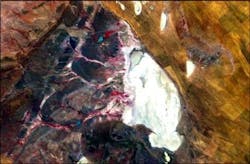How imaging factors into quest to break world land speed record
The Bloodhound Project, which is being led by a team of the world’s top engineers, has an ultimate goal of attaining a 1,000 mph world land speed record. The project’s vehicle, the Bloodhound SSC, is a supersonic car that is currently in development. When it comes to the vehicle’s potential success, things like the engines, wheels, and braking systems might come to mind first, but imaging and vision also have a large part to play in the Bloodhound’s quest for a world record.
It was recently announced that satellite imagery provided by DMCii is helping the Bloodhound Project team to monitor the test track conditions on the Hakskeen Pan in the Northern Cape of South Africa. The track must be completely dry before use, as only then does the surface have the right load-bearing capacity to support the supersonic car and ensure a safe run, according to a Bloodhound update. DMCii 22 meter multispectral imagery provides responsive high-resolution Earth imaging services from coordinated satellites of the international DMC Constellation, according to DMCii.
DMCii’s imagery helped the team to understand more about the environment they are working with and identify potentially problematic areas in the surface of the pan, which can factor in to ensuring that all runs are safe, says Andy Green, Bloodhound driver.
“Our own tests have shown that DMCii imagery gives an exact picture of the conditions on the ground, which will give me great confidence when I step into the driver’s seat of the world’s fastest car,” he said in the Bloodhound update.
In addition to DMCii’s services, the team has also enlisted the help of Stemmer Imaging to supply and integrate up to 11 cameras at strategic points on the car. Bloodhound is set to travel faster than a bullet fired from a Magnum 357 gun, covering the length of four-and-a-half football pitches in just one second, so video data will need to be date-stamped and linked into the on-board control electronics so that individual frames can be related back to control events, explains Mark Williamson, director of corporate market development at Stemmer Imaging.
Forward-facing cameras will deliver live streamed video for broadcast purposes while rear-facing cameras will look at the output from the rocket and jet engine exhausts. In addition, other cameras will monitor critical engineering parameters such as the wheel-ground interface, while cockpit cameras will monitor controls and driver actions, according to a Stemmer release.
Video data will be managed through an Ethernet data communication bus. Stemmer is currently working with the Bloodhound team to define how the system will work and be deployed.
View more information on The Bloodhound Project.
View more information on DMCii satellite imaging.
View the Stemmer Imaging release.
Also check out:
Camera helps control active high beam
Neptec wins contract to build cameras for Mars program
Share your vision-related news by contacting James Carroll, Senior Web Editor, Vision Systems Design
To receive news like this in your inbox, click here.
About the Author

James Carroll
Former VSD Editor James Carroll joined the team 2013. Carroll covered machine vision and imaging from numerous angles, including application stories, industry news, market updates, and new products. In addition to writing and editing articles, Carroll managed the Innovators Awards program and webcasts.
